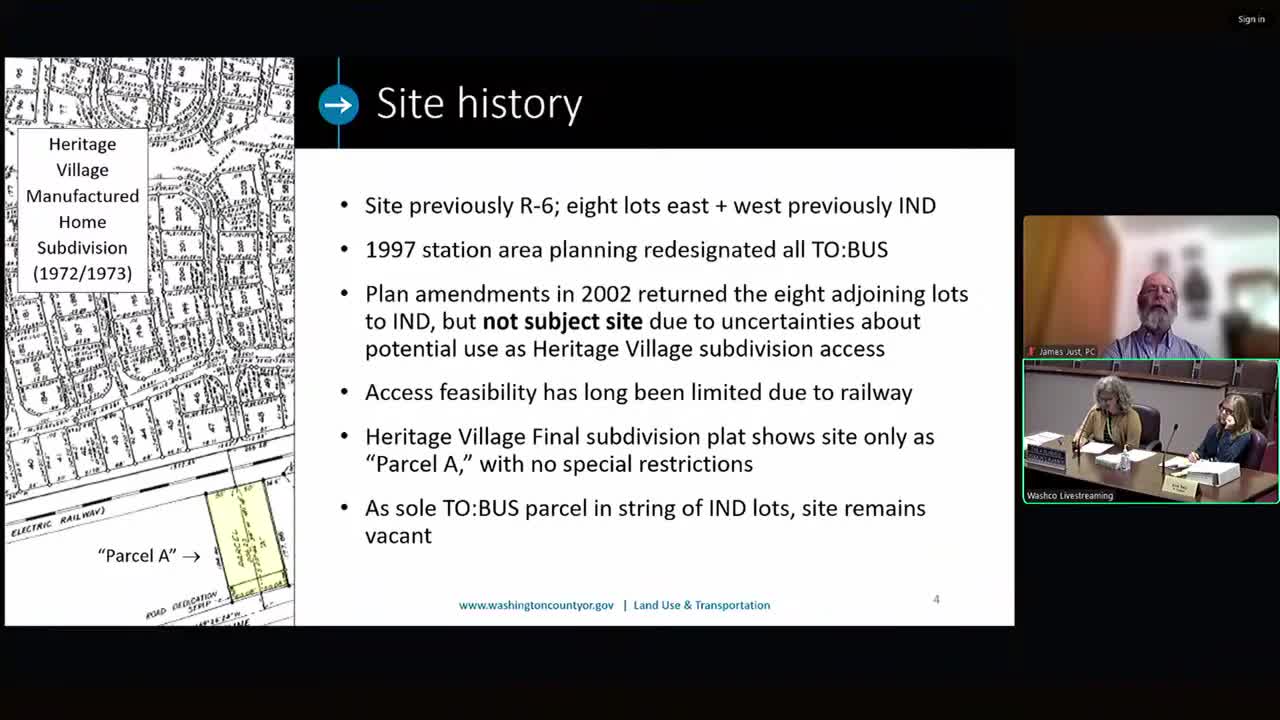Beaverton Planning Commission Reviews Heritage Village Subdivision Proposal Amendments
September 18, 2025 | Washington County, Oregon
This article was created by AI summarizing key points discussed. AI makes mistakes, so for full details and context, please refer to the video of the full meeting. Please report any errors so we can fix them. Report an error »

In a meeting that echoed with the weight of Washington County's planning history, officials gathered to discuss the future of a 0.36-acre parcel known as Parcel A, nestled between industrial developments and the MAX light rail line. The site, which has remained undeveloped, is located along West Baseline Road, a bustling five-lane arterial that serves as a vital transportation corridor.
The discussion began with a look back at the parcel's past, tracing its designation changes from Residential 6 to its current status as a transit-oriented business site. The Oregon Electric Railway, which operated until 1994, once ran adjacent to this land, marking a significant chapter in the area's transportation evolution. Despite its proximity to the Heritage Village subdivision and existing industrial properties, the site has faced uncertainty regarding its future use.
Key to the meeting was the proposal for a plan amendment that would align the site with the surrounding industrial landscape. Officials highlighted the importance of citizen involvement in the planning process, noting that notifications were sent to nearby property owners and public notices were published in local media. This outreach aimed to ensure that community voices were heard as decisions about land use were made.
The planning team presented their findings, asserting that the proposal complies with various planning frameworks, including the Statewide Planning Goals and the Washington County Comprehensive Framework Plan. They emphasized that the site’s designation as industrial is supported by the existing developments to the east and west, which have successfully integrated into the community.
However, the proposal also faced scrutiny regarding its alignment with the current designation of Transit Oriented Business. The planning commission acknowledged that while the site has potential for transit-related development, its immediate context and the surrounding industrial character may warrant a different approach.
As the meeting concluded, the implications of this discussion loomed large over Washington County's future development. The decisions made regarding Parcel A could set a precedent for how the county balances industrial growth with the need for transit-oriented solutions, reflecting the ongoing dialogue between history, community needs, and urban planning. The next steps will be crucial as stakeholders continue to navigate the complexities of land use in this evolving region.
The discussion began with a look back at the parcel's past, tracing its designation changes from Residential 6 to its current status as a transit-oriented business site. The Oregon Electric Railway, which operated until 1994, once ran adjacent to this land, marking a significant chapter in the area's transportation evolution. Despite its proximity to the Heritage Village subdivision and existing industrial properties, the site has faced uncertainty regarding its future use.
Key to the meeting was the proposal for a plan amendment that would align the site with the surrounding industrial landscape. Officials highlighted the importance of citizen involvement in the planning process, noting that notifications were sent to nearby property owners and public notices were published in local media. This outreach aimed to ensure that community voices were heard as decisions about land use were made.
The planning team presented their findings, asserting that the proposal complies with various planning frameworks, including the Statewide Planning Goals and the Washington County Comprehensive Framework Plan. They emphasized that the site’s designation as industrial is supported by the existing developments to the east and west, which have successfully integrated into the community.
However, the proposal also faced scrutiny regarding its alignment with the current designation of Transit Oriented Business. The planning commission acknowledged that while the site has potential for transit-related development, its immediate context and the surrounding industrial character may warrant a different approach.
As the meeting concluded, the implications of this discussion loomed large over Washington County's future development. The decisions made regarding Parcel A could set a precedent for how the county balances industrial growth with the need for transit-oriented solutions, reflecting the ongoing dialogue between history, community needs, and urban planning. The next steps will be crucial as stakeholders continue to navigate the complexities of land use in this evolving region.
View full meeting
This article is based on a recent meeting—watch the full video and explore the complete transcript for deeper insights into the discussion.
View full meeting
